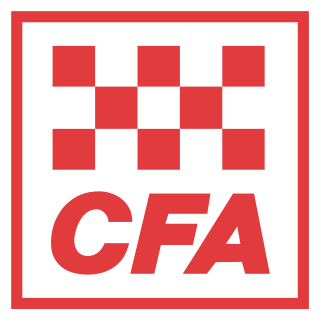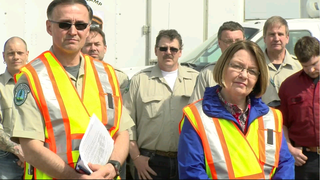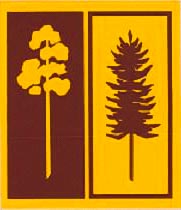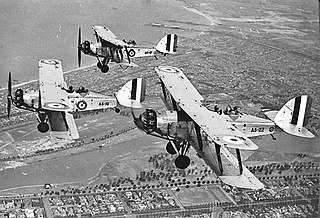
An agricultural aircraft is an aircraft that has been built or converted for agricultural use – usually aerial application of pesticides or fertilizer ; in these roles they are referred to as "crop dusters" or "top dressers". Agricultural aircraft are also used for hydroseeding.

Aerial firefighting is the use of aircraft and other aerial resources to combat wildfires. The types of aircraft used include fixed-wing aircraft and helicopters. Smokejumpers and rappellers are also classified as aerial firefighters, delivered to the fire by parachute from a variety of fixed-wing aircraft, or rappelling from helicopters. Chemicals used to fight fires may include water, water enhancers such as foams and gels, and specially formulated fire retardants such as Phos-Chek.

The Country Fire Authority (CFA) is a volunteer fire service responsible for fire suppression, rescues, and response to other accidents and hazards across most of the state Victoria, Australia. CFA comprises over 1,200 brigades organised in 21 districts, and shares responsibility for fire services with Fire Rescue Victoria, which employs full-time paid firefighters in major urban areas; and Forest Fire Management Victoria (FFMV), which manages fire prevention and suppression on Victoria's public lands. CFA operations and equipment are partly funded by the Victorian Government through its Fire Services Levy, and supplemented by individual brigades' fundraising for vehicles and equipment.

Police aviation is the use of aircraft in police operations. Police services commonly use aircraft for traffic control, ground support, search and rescue, high-speed car pursuits, observation, air patrol and control of large-scale public events and/or public order incidents. They may employ rotary-wing aircraft, fixed-wing aircraft, nonrigid-wing aircraft or lighter-than-air aircraft. In some major cities, police rotary-wing aircraft are also used as air transportation for personnel belonging to SWAT-style units. In large, sparsely populated areas, fixed-wing aircraft are sometimes used to transport personnel and equipment.

The New South Wales Rural Fire Service is a volunteer-based firefighting agency and statutory body of the Government of New South Wales.

Abu Dhabi Aviation Co. is an airline based in Abu Dhabi, United Arab Emirates. It serves oil-fields and economic facilities in the United Arab Emirates and other Arab states. Its main base is Abu Dhabi International Airport. Abu Dhabi Aviation is the largest commercial helicopter operator in the Middle East, operating and owning 58 aircraft in total comprising 51 helicopters., and 7 fixed-wing aircraft (DHC-8). The company employs over 1000 personnel, including 130 pilots and 250 engineers. The bulk of the company's business activity is in support of Abu Dhabi offshore oil and engineering and construction companies. Other business activities include medical evacuation, aerial construction, survey, photography, charter, and providing VVIP passenger transportation services. All aerial spraying of crops in the UAE and the majority of aerial spraying in Oman is carried out by ADA.

The Sikorsky S-64 Skycrane is an American twin-engine heavy-lift helicopter. It is the civil version of the United States Army's CH-54 Tarhe. It is currently produced as the S-64 Aircrane by Erickson Inc.

Conair Group Inc. of Abbotsford, British Columbia, Canada, formerly known as Conair Aviation, is a company specializing in retrofitting firefighting aircraft, maintaining customer and company-owned aircraft and aerial firefighting. Conair currently employs over 250 staff and has a fleet of aircraft that are broken down into two categories; air attack, and airtankers. Conair specializes in fire management support by providing services and products to forest protection agencies around the world. In 1996 Conair became a Canadian Air Tractor dealer for the AT-802F air tanker. A former Conair Group division; Cascade Aerospace was acquired by the IMP Group of Halifax, Nova Scotia in 2012.
Assault Support is one of the six functions of United States Marine Corps aviation and comprises those actions required to airlift personnel, supplies or equipment into or within a battle area by helicopters or fixed-wing aircraft. It provides the Marine Air-Ground Task Force commander the ability to concentrate his strength against selected weaknesses using speed and surprise. It also provides operational and tactical mobility as well as logistics support to the Marine Air-Ground Task Force. It is used to focus combat power at the decisive place and time to achieve local combat superiority.

The DC-10 Air Tanker is a series of American wide-body jet air tankers, which have been in service as an aerial firefighting unit since 2006. The aircraft, operated by the joint technical venture 10 Tanker Air Carrier, are converted wide body McDonnell Douglas DC-10-30 passenger jetliners, and are primarily used to fight wildfires, typically in rural areas. The turbofan-powered aircraft carry up to 12,000 US gallons of water or fire retardant in an exterior belly-mounted tank, the contents of which can be released in eight seconds. Four air tankers are currently in operation, all DC-10-30 aircraft, with the call-signs Tanker 910, 911, 912 and 914. The original Tanker 910, a DC-10-10, was retired in 2014.

Elvis is the nickname of Erickson S-64 Air-Crane, tail number OB-2081-P (N179AC), which has gained fame in Australia as a highly visible and valuable tool in bushfire suppression. The helicopter, which can hold 9,500 litres (2,500 US gal) of water or foam mix, has been brought out by the Victorian Government from the United States for each fire season since 2001-2002. The aircraft obtained its nickname due to the time that it spent working for the United States National Guard in Memphis, where singer Elvis Presley lived for most of his life.

In 2002, two large airtankers – a Lockheed C-130 Hercules and a Consolidated PB4Y-2 Privateer – crashed about a month apart while performing aerial firefighting operations. These crashes prompted a review of the maintenance and use of the entire U.S. large airtanker fleet. Ultimately, the whole fleet was grounded, dramatically reducing the resources available to fight major wildfires. Both aircraft were owned by Hawkins & Powers Aviation of Greybull, Wyoming and operated under contract to the United States Forest Service (USFS). The crashes occurred in one of the worst fire seasons in the last half century, one in which 73,000 fires burned 7.2 million acres (29,000 km2) of land.

The Direction générale de la sécurité civile et de la gestion des crises is a civil defense agency of the French Government. It operates for the Ministry of the Interior and employs some 2,500 civilian and military personnel over 60 sites. Known as the Protection Civile until 1976, the Sécurité Civile is split into several branches:
Wildfire suppression equipment and personnel is part of the science of fire fighting focusing on the use of specialized equipment, training and tactics to effectively control, surround and eventually extinguish a natural cover fire. There are several specially designed tools that through their function and user training, perform specialized tasks that are specific to natural cover firefighting. This is used together in conjunction with the general understanding of the behavior of fire to form a viable plan of attack.

The Air Wing is the police aviation unit of Victoria Police that operates in metropolitan Melbourne and provides a service to the whole of Victoria.
Neptune Aviation Services Inc. is an aerial firefighting company based out of Missoula International Airport in Missoula, Montana. It provides aerial support and firefighting to the United States, Canada, Chile and throughout the world. Founded in 1993, Neptune Aviation is known for aerial firefighting, aviation maintenance, fixed-base operator and air charter operations.

BC Wildfire Service (BCWS) is the wildfire suppression service of the Canadian province of British Columbia. It is an element of the Ministry of Forests, Lands, Natural Resource Operations and Rural Development.

The Forests Commission Victoria (FCV) was the main government authority responsible for management and protection of State forests in Victoria, Australia between 1918 and 1983.

The development of aerial firefighting and forestry in southern Australia ran in parallel with the rapid improvements in aircraft technology over the last century. As more advanced and capable aircraft became available firefighters and foresters quickly sought opportunities to utilise and adapt them.
The Royal Commission into National Natural Disaster Arrangements, also referred to as the Bushfires Royal Commission, was a royal commission established in 2020 by the Australian government to inquire into and report upon natural disaster management coordination as it related to the 2019–20 Australian bushfire season. The Commission was charged with the responsibility of examining the coordination, preparedness for, response to and recovery from disasters, as well as improving resilience and adapting to changing climatic conditions and mitigating the impact of natural disasters.

















